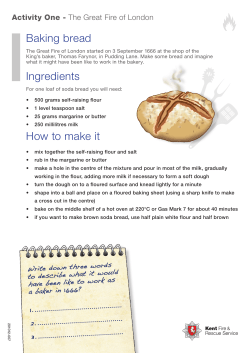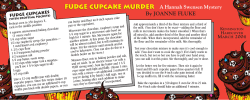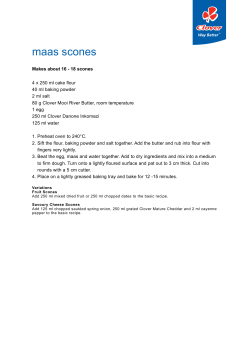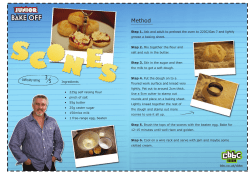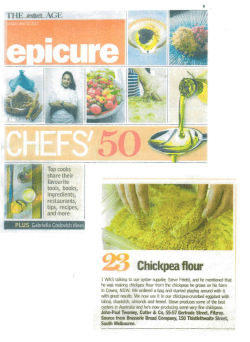
Herald Sun Tuesday 2/3/2010
Herald Sun
Tuesday 2/3/2010
Page: 33
Section: Taste
Region: Melbourne Circulation: 514,000
Type: Capital City Daily
Size: 2,063.08 sq.cms.
Frequency: MTWTFS-
Brief: HGRANT
Page 1 of 6
Why nannas are the new celebrity ch s
Copyright Agency Limited (CAL) licenced copy
Ref: 65513303
Herald Sun
Tuesday 2/3/2010
Page: 33
Section: Taste
Region: Melbourne Circulation: 514,000
Type: Capital City Daily
Size: 2,063.08 sq.cms.
Frequency: MTWTFS-
Brief: HGRANT
Page 2 of 6
Why Nanna
knows best
Simple food returns, writes Natascha Mirosch
M
i
ZY
grandmothers taught me a lot
about food. My Russian
grandmother instilled a love of
cooking, my English grandma
provided a perfect example of
how not to do it.
The latter was a fine woman
with many talents, but her
kitchen skills were dismal. We
were subjected on many
miserable occasions to her
dried-out meatloaf and limp,
grey vegetables.
Sadly, neither are around
any more, but their legacy
lingers on in my own kitchen.
I may never have mastered my
Russian grandmother's perfect
piroshki but I can cook a
meatloaf that's the antithesis
of my English grandmother's.
Over the past 50 years, the
knowledge once passed down
from our grandparents or
mothers had almost trickled
away, as we eschewed the old
and true for fast, novel foods.
We wanted instant, precooked and packaged food
ready to be microwave-zapped
and on the table in
under 10 minutes.
But a renaissance is putting
nannas and their comfort food
back in the kitchen.
Fast food may have been the
maxim of recent decades, but
slow food is the noughties
catchword. Generations X and
Y are picking up wooden
spoons and taking pleasure in
spending time in the kitchen
with recipes their nans might
have cooked while slowcooked, from-scratch dishes
with the emphasis on
simplicity are being showcased
in food publications.
MasterChef's Gary Mehigan
has released a cookbook called
Comfort Food and reckons
food security and health issues
are partly responsible for
turning us back to the tried
and true.
"We're all very conscious of
the impact of convenience
foods," he says. "Then there's
a resurgence in young people
wanting to know how to cook,
which is gratifying.
"They're looking for simple
recipes - a muffin or scone
recipe that's going to work."
People are also realising
that home cooking needn't
mean long hours in the
kitchen. Gary cites the
pressure cooker and slow
cooker as essential items for
time-poor cooks.
"My mum used a pressure
cooker," says Gary. ''I find
myself doing the same. I'll put
something in like a spag bol
when my daughter goes to
school so I don't have to come
home and cook."
Aucklander Natalie Oldfield
was on to the nanna food
trend years ago. She has a shop
and sells old-fashioned
produce, preserves and
homemade muesli made to her
grandmother Dulcie May's
recipes, and has written her
first cookbook, Grans Kitchen,
Recipes from the Notebooks of
Dulcie Mad', (Hardie Grant
Books, out April). The recipes
such as coconut ice and
cottage pie are standard granfare. Natalie says she grew up
cooking with Dulcie May.
"She had the gardens full of
fresh produce - it was always
all about food when we were
with her. She was really
patient, and could be quite
bossy, but she was always
encouraging with the end
result."
In the writing, Natalie spent
four months cooking with her
gran, then in her mid-90s, who
has since passed away.
"There was always a story
Copyright Agency Limited (CAL) licenced copy
connected to it," she says.
Natalie believes not only
nostalgia has seen us turn back
to nanna food, but the
simplicity of what they cooked.
Her own childhood
favourite is Napoleons, pretty
pink-iced puff pastries.
Gary also pays tribute to his
roots, albeit to his grandfather.
"I grew up thinking I'd be
an engineer or architect.
"When I was 15 I realised
how much I loved cooking
with my grandfather, who was
a chef. I'd go there and be
absolutely spoiled, with freshly
baked bread, rockcakes and
Bakewell tart.
"Then he'd cook carrots
Vichy, straight from his
garden, the best carrots you
could ever eat. It used to drive
my mum nuts that I would eat
them at his place, but never
at home."
Comfort food, as Gary
points out, is very subjective.
He says it's not surprising
that in a world of
uncertainty, we're returning to
older values.
"It's about cooking
together and the warm fuzzy
feeling you get when
you make a dish from a
special moment."
Ref: 65513303
Herald Sun
Tuesday 2/3/2010
Page: 33
Section: Taste
Region: Melbourne Circulation: 514,000
Type: Capital City Daily
Size: 2,063.08 sq.cms.
Frequency: MTWTFS-
Brief: HGRANT
Page 3 of 6
Lh- &I
Gary Mehigan's
Recipes and
cover image
from the book
Comfort Food
by Gary
Mehigan,
rrp $49.95,
© Lantern
2010,
available
March 29.
I
liKE 1
OLA Macleod still
takes pride in the
way she cooked
for her family as
her four children
were growing up.
We served up nutritious
meals and we sat at the table to
eat them," she says of herself
and other home cooks of
her generation.
"Dinner time was virtually
the only time the whole family
could be together, and just as
important as eating was being
together and hearing about the
highs and lows of the day."
u Kes
0
Roasts were a favourite with
the country-dwelling Macleod
children, as were Nola's chow
mein, sausage rolls (with plenty
of vegetables in them) and
homemade spaghetti.
To earn their dessert, the
children each needed to have
three brussels sprouts.
"I love them if they're
cooked properly," she says of
the once-unfashionable vegie,
to which she adds bacon, onion,
herbs and a little butter.
And her desserts sound
worth the trouble. To please
the children and to raise money
for local community groups,
Nola pumped out a stream of
scones, pavlovas, sponge cakes
and cheesecakes.
Now 70 and with 19 grandchildren, she is still a busy cook.
Nola has them over two at a
time during school holidays
and teaches them cooking.
"I've taught them to make
scones and muffins - all sorts of
things. How to make
shortcrust pastry or biscuit
pastry, and they've made
things like pasties, apple pies
and j am tarts."
The Glen Waverley resident
Copyright Agency Limited (CAL) licenced copy
is still asked by her daughters
to bring cheesecake, scones or
pays to parties, as well as
chocolate eclairs cooked in her
mother's original eclair tins.
And she has noticed a
resurgence in the popularity of
traditional cooking, and recalls
a group of women in their 30s
approaching the Country
Women's Association, Victoria
(of which she is former
president) asking for lessons in
`'cooking how grandma
cooked" - right down to the
fruit bottling.
- Wendy Tuohy
Ref: 65513303
Herald Sun
Tuesday 2/3/2010
Page: 33
Section: Taste
Region: Melbourne Circulation: 514,000
Type: Capital City Daily
Size: 2,063.08 sq.cms.
Frequency: MTWTFS-
Brief: HGRANT
Page 4 of 6
Nutritious, delicious: Nola Macleod with granddaughter Alexandra. Picture: Ben Swinnerton
Copyright Agency Limited (CAL) licenced copy
Ref: 65513303
Herald Sun
Brief: HGRANT
Page 5 of 6
Tuesday 2/3/2010
Page: 33
Section: Taste
Region: Melbourne Circulation: 514,000
Type: Capital City Daily
Size: 2,063.08 sq.cms.
Frequency: MTWTFS-
I ultu
11 t! t
.1f
Makes 6
375g self-raising flour
Pinch table salt
2 tbsp caster sugar
100g dates, pitted and chopped
50g walnuts, chopped
Finely grated zest of 1 lemon
150m1 milk, plus extra for
brushing
150m1 pouring cream
2 eggs
Plain flour, for dusting
Thick cream and homemade
jam, to serve
Preheat fan-forced oven to
180C. Sift the flour, salt and
sugar into a bowl. Add the
dates, walnuts and lemon zest
and mix lightly. Make a well in
the centre of the flour mixture.
Whisk the milk, cream and
eggs in a small bowl. Pour the
milk mixture into the well in
the flour mixture.
Using your fingers, gently
draw the flour mixture into the
milk mixture to form a soft
dough; it is very important not
to overwork the dough because
it may make the scones tough.
Tip the dough on to a floured
surface and gently form into a
ball. Press lightly to flatten with
your fingertips.
Gently roll out until it is
2-3cm thick. Use a 5-6cm scone
or biscuit cutter to cut into
rounds. Place rounds on a nonstick baking tray and brush
with a little milk.
Bake the scones for 20
minutes, or until golden. Serve
warm. There is nothing better
than a big dollop of thick cream
and homemade jam to make
them extra special.
I fj i)U
Serves 4
200g short-grain rice
850m1 milk, plus 150ml extra
if needed
1/2 vanilla pod, split
3 egg yolks
100g caster sugar
1/3 cup good strawberry jam
Place the rice, milk
and vanilla pod in a large
heavy-based saucepan.
Bring to the boil, then
simmer over a low heat
for 45 minutes, or until
the rice is tender.
Stir regularly,
otherwise the milk and
rice will stick to the base of
the pan and may burn.
Add a little more milk if
required to keep the mixture
soft and creamy.
As the rice becomes soft
(after about 40 minutes),
whisk the egg yolks and
Copyright Agency Limited (CAL) licenced copy
Ii
sugar in a bowl until they are
pale and creamy.
Remove rice from heat and
pour it into the egg mixture,
then combine, stirring quickly
with a flexible spatula.
Serve the hot rice pudding
in bowls, topped with a
dollop of homemade
strawberry jam.
n
Ref: 65513303
Herald Sun
Brief: HGRANT
Page 6 of 6
Tuesday 2/3/2010
Page: 33
Section: Taste
Region: Melbourne Circulation: 514,000
Type: Capital City Daily
Size: 2,063.08 sq.cms.
Frequency: MTWTFS-
[M)
L.UUIl II[_) We t- CII
Serves 4
30m1 olive oil
1kg boneless lamb leg, cut into
4cm chunks
2 carrots, cut into large chunks
2 onions, cut into large chunks
3 cloves garlic, coarsely chopped
2 sprigs thyme
3 fresh bay leaves
2 tbsp tomato paste
8 tomatoes, peeled
seeded and quartered
1 litre strong veal stock
Table salt and freshly ground
white pepper
Finely grated zest of 1 lemon
2 tbsp coarsely chopped
flat-leaf parsley
DUMPLINGS
150g self-raising flour,
plus extra if needed
150g suet mix
1 tsp table salt
180ml cold water
Preheat oven (fan-forced) to
165C. Heat a large heavy-based
saucepan or enamelled casticon casserole over high heat,
then add oil. Working in
batches, brown the lamb for 6-8
minutes, then remove and set
aside. Brown the carrot, onion
and garlic for 3-4 minutes, then
add the thyme and bay leaves.
Return meat to the pan. Add
tomato paste and stir to
combine, then stir in the
ago
WF'_4110
with pangrat1.cit.o
200m1 milk
s; 4'{
tomato and veal stock. Bring to
the boil and season.
Pop on a lid and cook in the
oven for 2 hours, or until the
meat is tender.
Remove from the oven,
remove the thyme and bring
the stew back to a gentle
simmer over low heat while
you make the dumplings.
For the dumplings, mix the
flout', suet mix and salt in a
large bowl. Make a well in the
centre, then pour in the water
and mix gently by hand; add
extra flour if needed for the
mixture to just come together.
Form into 2cmn balls and drop
them on to the surface of the
bubbling stew. Pop on the lid
and simmer for 6-8 minutes.
Turn off the heat and leave
covered for 2 minutes.
Sprinkle the lemon zest and
parsley over the stew and serve
at once with the dumplings.
Suet mix is available in the
baking supplies section in good
supermarkets.
.
20g unsalted butter
20g plain flour
40g tasty cheese, grated
1.5 litres water
Table salt
1 small cauliflower, trimmed,
cut into florets
50m1 pouring cream
1 egg yolk
70g grated Parmigiano Reggiano
3 tbsp pangrattato*
Bring milk to the boil in a
saucepan over high heat, then
remove. Melt the butter in
another pan over medium heat.
Add the flour and stir for 2-3
minutes or until white tinges
appear on the flour and butter
mixture (this is called a roux).
Add a ladle of the hot milk at
a time to the roux. Before
adding more hot milk, stir the
mixture until it is smooth.
Reduce the heat to low
and cook the sauce
for another 5-6
minutes,
,ff.,&
stirring regularly to prevent the
mixture from sticking.
Remove from heat. Stir in
the grated cheese. Set aside.
Preheat oven (fan-forced) to
180C. Bring water to the boil in
a large pan and add a pinch of
salt. Cook the cauliflower for
5 minutes, or until just tender.
Remove cauliflower, then
drain; ensure it is completely
dry. Arrange it in a baking dish
with the florets facing upwards.
Whip the cream with a
whisk. Mix the egg yolk into
the cheese sauce, then fold in
the whipped cream and
parmesan. Spoon the sauce
over the cauliflower so it is
covered, then sprinkle with the
pangrattato.
Bake for 10 minutes or until
bubbly and golden and serve.
Pangrattato is an Italian
pasta topping of breadcru nbs
fried in garlic oil.
-,
f
1 L
w
Tr
db
,N
Copyright Agency Limited (CAL) licenced copy
Ref: 65513303
© Copyright 2025
